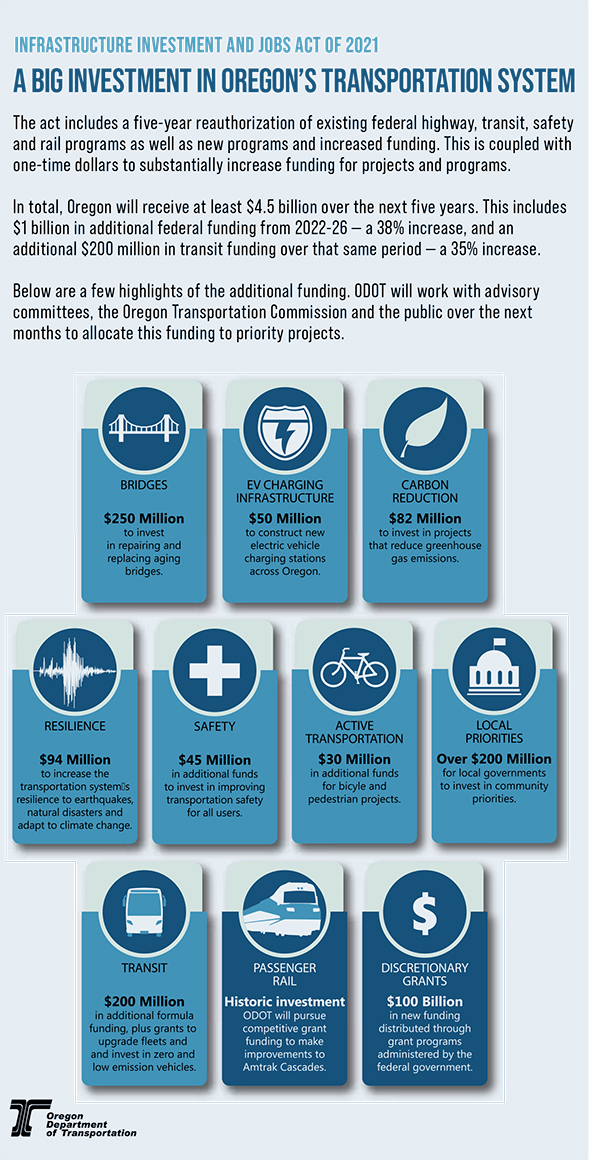Oregon has the second-best infrastructure in the U.S., according to the Best States 2021 ranking from U.S. News & World Report. Infrastructure is one of eight index components used to form the publication’s overall Best States ranking. It measures three factors: (1) Energy in terms of reliability of power grids, renewable energy consumption and the price of electricity; (2) Access to broadband and high-speed Internet; and (3) Transportation — average commute time, road quality, unstable bridges and public transit usage.
These subfactors, too, are ranked nationally with Oregon placing first, 20th and third, respectively. Oregon beats the national average in its use of renewable energy with 49.1% compared with 11.2% nationally. And just 7.3% of Oregon’s roads are considered to be in poor condition; the national average is 19.9%.
In 2018, Governor Kate Brown established by executive order the Oregon Broadband Office, which opened in 2019. The office has several functions, including to support and coordinate efforts with the Oregon Broadband Advisory Council; to develop and maintain a broadband map as a platform for data collection to track the availability of broadband services and measure progress; to develop broadband investment and deployment strategies and manage and award funds allocated to the office for broadband projects; and to advocate for public policies that remove barriers, promote and coordinate solutions, support and promote broadband planning.
‘A Gamechanger for Oregon’
The Broadband Office and other state agencies linked to Oregon’s infrastructure are about to become a lot busier. In November 2021, following passage of the federal Infrastructure Investment and Jobs Act, Gov. Brown observed: “This historic investment will be a gamechanger for Oregon, and our nation — rebuilding our roads and bridges, bringing affordable broadband and clean drinking water to our communities, and building Oregon’s resilience to natural disasters. Infrastructure is critical to supporting the way Oregonians live, travel and stay active. This bill will both modernize our infrastructure and bring good-paying jobs to communities across our state — all while helping tackle climate change. We are excited and ready.”
What does the Act mean specifically for Oregon? It will bring billions of dollars in federal funding to the Beaver State, including an expected $268 million for bridge replacement and repairs and $3.4 billion to help modernize Oregon’s roads and highways. Oregon can also compete for the $12.5 billion Bridge Investment Program for economically significant bridges and nearly $16 billion of national funding in the bill dedicated for major projects that will deliver substantial economic benefits to communities.
The state also expects to receive $747 million to upgrade public transportation systems over the next five years and more than $52 million to establish new Electric Vehicle charging infrastructure. Oregon will also have the opportunity to apply for the $2.5 billion in grant funding dedicated to EV charging in the bill.
Relative to Internet access, Oregon will receive a minimum allocation of $100 million to help provide broadband coverage across the state, including providing access to the at least 136,600 Oregonians who currently lack it. And, under the Infrastructure Investment and Jobs Act, 945,000 or 23% of people in Oregon will be eligible for the Affordability Connectivity Benefit, which will help low-income families afford internet access.
Other provisions of the Infrastructure Investment and Jobs Act include an expected $529 million to provide clean drinking water and improve water infrastructure and an expected $32 million to protect against wildfires. And Oregon would receive approximately $211 million for infrastructure development for airports over five years.


